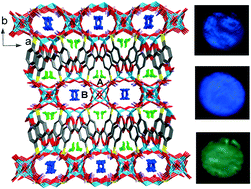Structure evolution and luminescence properties of lithium(i)–sulfonate complexes constructed from multifunctional arenedisulfonic acids†
Abstract
Self-assembly of three multifunctional arenedisulfonic acids and different lithium(I) salts leads to the formation of eight lithium(I)–sulfonate complexes, namely, [Li(H3L1)(H2O)2]2 (1), [Li2(H2L1)(H2O)3.5]n·1.5nH2O (2), [Li2(H2L2)(H2O)3]n·nH2O (3), [Li3(H3L2)(H2L2)(H2O)2]n·nH2O (4), [Li(H3L3)(H2O)]n·nH2O (5), [Li2(H2L3)(H2O)4]n·3nH2O (6), [Li2(H2L3)(H2O)2.5]n·3nH2O (7), and [Li3(HL3)(H2O)5]n·0.5nH2O (8) (H4L1 = 2,3-dihydroxyl-5-carboxylbenzenesulfonic acid; H4L2 = 2,5-dihydroxyl-3-carboxylbenzenesulfonic acid; H4L3 = 2,4-dihydroxyl-5-carboxylbenzenesulfonic acid), which have been synthesized and characterized by elemental analysis, IR, TG, PL, and powder and single-crystal X-ray diffraction. The H3L1− monoanion in complex 1 acts in μ2 (κ1O1:κ1O6) mode and bridges two adjacent Li(I) cations to generate a dinuclear motif. By contrast, the H2L12− dianion in complex 2, exhibiting an intricate μ5 (κ1O3:κ1O4:κ1O5:κ2O6:κ1O7) coordination mode, connects adjacent Li(I) cations to form a layer structure, in which a strong Li⋯Li interaction (2.574(8) Å) is firstly observed among Li(I)–sulfonates. Complex 3 exhibits a ladder chain formed by the H2L22− dianion bridging Li(I) cations in simple μ3 (κ1O1:κ1O3:κ1O4:κ2O6) coordination mode. Complex 4 shows a 3-D host–guest framework with free water molecules occupying the channels, in which the H3L2− monoanion and the H2L22− dianion act in μ4 (κ1O9:κ2O10:κ1O11:κ1O13) and μ5 (κ1O1:κ2O3:κ1O4:κ1O6:κ1O7) coordination modes, respectively. Complex 5 exhibits a linear chain motif with the H3L3− monoanion acting in simple μ2 (κ1O1:κ1O2:κ1O4) coordination mode. The H2L32− dianions in complexes 6 and 7 present different μ3 (κ1O2:κ1O3:κ1O4:κ1O5) and μ5 (κ1O1:κ2O2:κ1O3:κ1O4:κ1O6) coordination modes, which then result in the formation of linear chains and layer structures. Complex 8 also shows a 3-D host–guest framework with free water molecules occupying the channels, in which the HL33− trianion acts in μ4 (κ1O2:κ1O3:κ1O4:κ1O5:κ1O7) mode. The structural diversities and evolution of these complexes can be attributed to the diverse polyhedra of Li(I) cations and the coordination modes of the different functional groups induced by the pH value. The solid-state luminescence properties demonstrate that all of these complexes exhibit strong emission in the range of 374–537 nm at room temperature.



 Please wait while we load your content...
Please wait while we load your content...